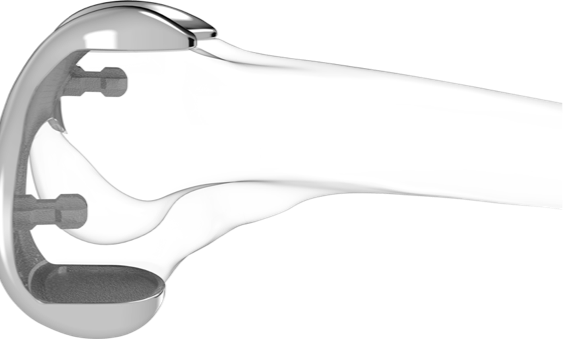Knee Replacement Clinical Studies
Conformis is dedicated to advancing understanding of our products and their benefits to patients, surgeons, and hospitals through knee replacement clinical studies.
The high performance of Conformis’ patient-specific knee implants has been researched and published in multiple, reputable, peer-reviewed medical journals over the past decade. Peer-reviewed medical journal articles are written by researchers and medical experts and must be reviewed by several other experts in the field before the articles may be published, in order to ensure the articles’ quality, and reasonableness of conclusions.
This page highlights some of the most important conclusions of this research, with general summaries of the supporting journal articles, links to which may be found to provide greater detail to medical professionals below.
Summaries of Clinical Studies on Conformis’ Patient-Specific Knee Implants


As generic, off-the-shelf implants are manufactured in limited, pre-determined sizes, they do not always adequately fit the patient anatomy. Patient-specific implants are designed to fit each individual, so this study of 24,042 knees suggests that greater adoption of patient-specific procedures could potentially reduce the overall number of soft tissue releases and medical resections (surgical removal of tissue).
Meier, M., Zingde, S., Steinert, A., Kurtz, W., Koeck, F., & Beckmann, J. (2019). What is the possible impact of high variability of distal femoral geometry on TKA? A CT data analysis of 24,042 knees. Clinical Orthopaedics and Related Research®, 477(3), 561-570.
Over-hang of implant components, where the implant is larger than the patient’s bone, can lead to pain post-surgery. Patient-specific implants, which are designed to match each patient’s unique bone geometry, achieved rotational alignment and tibial (shinbone) fit without causing over-hang of the tibial tray.
Schroeder, Lennart and Martin, Greg. “In Vivo Tibial Fit and Rotational Analysis of a Customized, Patient-Specific TKA versus Off-the-Shelf TKA.” The Journal of Knee Surgery Published Online: May 25, 2018, https://www.thieme-connect.com/products/ejournals/html/10.1055/s-0038-1653966
Both oversized and undersized knee implants can result in patient discomfort during daily activities. Oversized implants can result in soft tissue impingement and knee pain, while undersized implants can lead to implant subsidence (loosening of implant components). One year after surgery, patients with patient-specific implants reported high levels of function while performing activities of daily living, while also exhibiting good strength and mechanics.
Wang, Henry, Jonathan Foster, Natasha Franksen, Jill Estes, and Lindsey Rolston. “Gait analysis of patients with an off-the-shelf total knee replacement versus customized bi-compartmental knee replacement.” International Orthopaedics Published Online: September 4, 2017 (doi: https://doi.org/10.1007/s00264-017-3622-z).
Patient-specific implants demonstrated good coverage of the tibia (shinbone) and provided excellent short-term clinical and radiological results as well.
Demange, Marco K., Arvind Von Keudell, Christian Probst, Hiroshi Yoshioka, and Andreas H. Gomoll. “Patient-Specific Implants for Lateral Unicompartmental Knee Arthroplasty.” International Orthopaedics 39.8 (2015): 1519-1526. https://doi.org/10.1007/s00264-015-2678-x
Poor fit for the tibial (shinbone) component of a knee implant can lead to pain, loosening, and subsidence (tilting and sinking of the implant). Patient-specific implants cover the cortical bone (dense outer surface of bone) with good fit, while minimizing over-hang and under-coverage.
Carpenter, Dylan, Rebecca Holmberg, Marc Quartulli, and C. Lowry Barnes. “Tibial Plateau Coverage in UKA: A Comparison of Patient-Specific and Off-the-Shelf Implants.” The Journal of Arthroplasty 29.9 (2014): 1694-1698. https://doi.org/10.1016/j.arth.2014.03.026


Patients with patient-specific implants demonstrated good fit, and patients’ outcomes for pain and stiffness (KSS and WOMAC) improved dramatically after surgery.
Steinert, Andre F., Johannes Beckmann, Boris Michael Holzapfel, Maximilian Rudert, and J. Arnholdt. “Bicompartmental individualized knee replacement: Use of patient-specific implants and instruments (iDuo™).” Operative Orthopädie und Traumatologie 29.1 (2017): 51-58. https://doi.org/10.1007/s00064-017-0484-x
Patients with patient-specific implants consistently achieved improved pain scores (KSS) at each follow up visit with their surgeon, with excellent results at one year. The Conformis iDuo knee appears to be a good option for those with isolated bi-compartmental disease.
Jemmett, Peter, and Stuart Roy. “The iDuo Bi-compartmental knee replacement: our early experience.” Reconstructive Review 6.4 (2016): 13-17.


Patients with patient-specific implants were found to have low amounts of bone resected on both the femur (thighbone) and tibia (shinbone) This creates the potential for less invasive revision surgery in the future.
Kurtz, William, John Slamin, and Scott Doody. “Bone Preservation in a Novel Patient-Specific Total Knee Replacement.” Reconstructive Review 6.1 (2016): 23-29.
https://www.reconstructivereview.org/ojs/index.php/rr/article/view/133/164
http://dx.doi.org/10.15438/rr.6.1.133
Patient-specific implants enable an approach that preserves the femoral bone (thighbone) and enhances cortical bone support on the tibia (dense outer surface of the shinbone). Patient-specific implants can restore normal anatomy, the position of the joint line, and normal joint function, with the potential to result in more normal knee movement and motion.
Fitz, Wolfgang. “Unicompartmental Knee Arthroplasty with Use of Novel Patient-Specific Resurfacing Implants and Personalized Jigs.” Journal of Bone and Joint Surgery. American Volume 91. Supplement 1 (2009): 69–76.


Incorrect positioning and malalignment of total knee arthroplasty (TKA) components can result in implant wear and pain. Patient-specific implants were found to achieve a high percentage of neutral leg alignment in the patients studied.
Arbab, D., Reimann, P., Brucker, M., Bouillon, B., & Lüring, C. (2018). Alignment in total knee arthroplasty—A comparison of patient-specific implants with the conventional technique. The Knee, 25(5), 882-887. https://doi.org/10.1016/j.knee.2018.05.017
Over-hang of implant components, where the implant is larger than the patient’s bone, can lead to pain post-surgery. Patient-specific implants, which are designed to match each patient’s unique bone geometry, achieved rotational alignment and tibial (shinbone) fit without causing over-hang of the tibial tray.
Schroeder, Lennart and Martin, Greg. “In Vivo Tibial Fit and Rotational Analysis of a Customized, Patient-Specific TKA versus Off-the-Shelf TKA.” The Journal of Knee Surgery Published Online: May 25, 2018 https://www.thieme-connect.com/products/ejournals/html/10.1055/s-0038-1653966
The kinematics (features or properties of motion in the replaced knee) of patient-specific knee implants were found to be similar to those of normal, unaffected knees. This can potentially help patients with patient-specific implants to achieve better function and stability in their knee post-surgery.
Zeller, Ian M., Adrija Sharma, William B. Kurtz, Mathew R. Anderle, and Richard D. Komistek. “Customized versus patient-sized cruciate-retaining total knee arthroplasty: an in vivo kinematics study using mobile fluoroscopy.” The Journal of Arthroplasty 32.4 (2017): 1344-1350. http://dx.doi.org/10.1016/j.arth.2016.09.034
Patient-specific implants with patient-specific cutting blocks approximate the natural kinematics (features or properties of motion in an object) of the knee well.
Patil, Shantanu, Adam Bunn, William D. Bugbee, Clifford W. Colwell Jr., and Darryl D. D’Lima. “Patient-Specific Implants with Custom Cutting Blocks Better Approximate Natural Knee Kinematics than Standard TKA without Custom Cutting Blocks.” The Knee 22.6 (2015): 624–629. http://dx.doi.org/10.1016/j.knee.2015.08.002
Data suggests that patient-specific implants reliably reproduce the mechanical axis of the limb (line extending from the center of the hip joint to the middle of the ankle joint).
Ivie, Conrad B., Patrick J. Probst, Amrit K. Bal, James T. Stannard, Brett D. Crist, and B. Sonny Bal. “Improved Radiographic Outcomes with Patient-Specific Total Knee Replacement.” The Journal of Arthroplasty 29.11 (2014): 2100-2103. https://doi.org/10.1016/j.arth.2014.06.024
The two primary goals of successful partial knee replacement are implant positioning and knee alignment. Patient-specific implants can restore leg axis reliably and attain a medial proximal tibial (shinbone) angle of 90 degrees – MPTA is the commonly used angle that is simply measured from knee radiographs. Patient-specific implants can also avoid mal-positioning of the implant and ensure maximum coverage of the shinbone.
Koeck, Franz Xaver, Johannes Beckmann, Christian Luring, Bjoern Rath, Joachim Grifka, and Erhan Basad. “Evaluation of Implant Position and Knee Alignment after Patient-Specific Unicompartmental Knee Arthroplasty.” The Knee 18.5 (2011): 294-299. http://dx.doi.org/10.1016/j.knee.2010.06.008


Patient-specific implants, when implanted with patient-specific instruments, restored neutral coronal mechanical axis (line extending from the center of the hip joint, passing through the center of the knee, to the middle of the ankle joint) very accurately, while offering customized implant fit and the restoration of patient J-curves (radius of curvature of the pair of large flared prominences on the end of the femur, where the femur forms the knee joint with the tibia).
Levengood, Gary A., and Jack Dupee. “Accuracy of coronal plane mechanical alignment in a customized, individually made total knee replacement with patient-specific instrumentation.” The Journal of Knee Surgery Published Online: December 14, 2017
(doi: https://www.thieme-connect.com/products/ejournals/html/10.1055/s-0037-1608946).
Patient-specific implants optimize coverage and restores the individual J-curves (radius of curvature) of all three compartments of the knee – (1) Medial compartment (the inside part of the femur); (2) Lateral compartment (the outside part); and (3) Patellofemoral compartment (the front of the knee between the kneecap and thighbone). Patient-specific implants restore the distal femoral offset, which decreases the need for surgeons to balance the ligaments, and restores the original distance between the origin and insertion of all ligaments. The patient-specific implant is engineered to optimize the contact area without increasing constraint (restrictions in movement), to restore the mechanical axis to neutral using pre-navigated, disposable instruments, and to reduce the femoral component thickness to preserve bone.
Schwechter, Evan M., and Wolfgang Fitz. “Design Rationale for Customized TKA: A New Idea or Revisiting the Past?” Current Reviews in Musculoskeletal Medicine 5.4 (2012): 303–308. https://www.ncbi.nlm.nih.gov/pmc/articles/PMC3702755/pdf/12178_2012_Article_9143.pdf


Patients with patient-specific implants experienced low transfusion rates and low adverse event rates. These patients also exhibited a trend toward short hospital stays and good discharge dispositions (higher likelihood of being discharged back home as opposed to a rehab facility), all without increased hospital costs.
Culler, Steven D., Greg M. Martin, and Alyssa Swearingen. “Comparison of adverse events rates and hospital cost between customized individually made implants and standard off-the-shelf implants for total knee arthroplasty.” Arthroplasty Today 3.4 (2017): 257–263.
http://www.arthroplastytoday.org/article/S2352-3441(17)30040-7/pdf (doi: http://dx.doi.org/10.1016/j.artd.2017.05.001)
The use of patient-specific implants is associated with relatively low estimated blood loss and length of hospital stay, with no discernible difference in surgical time.
Schwarzkopf, Ran, Merrick Brodsky, Giancarlo A. Garcia, and Andreas H. Gomoll. “Surgical and Functional Outcomes in Patients Undergoing Total Knee Replacement with Patient-Specific Implants Compared with ‘Off-the-Shelf’ Implants.” Orthopaedic Journal of Sports Medicine 3.7 (2015): 1-6.
http://journals.sagepub.com/doi/pdf/10.1177/2325967115590379


Patients with patient-specific implants experienced low transfusion rates and low adverse event rates. These patients also exhibited a trend toward short hospital stays and good discharge dispositions (higher likelihood of being discharged back home as opposed to a rehab facility), all without increased hospital costs.
Culler, Steven D., Greg M. Martin, and Alyssa Swearingen. “Comparison of adverse events rates and hospital cost between customized individually made implants and standard off-the-shelf implants for total knee arthroplasty.” Arthroplasty Today 3.4 (2017): 257–263.
http://www.arthroplastytoday.org/article/S2352-3441(17)30040-7/pdf (doi: http://dx.doi.org/10.1016/j.artd.2017.05.001)
Sobre a Conformis
Começamos com uma ideia simples - fazer com que o implante se encaixe ao paciente, ao invés de fazer o paciente a se encaixar ao implante
Sobre a Conformis



 PrecisionEffect and SurveyHealthcare Knee Implant Patient Survey 2018
PrecisionEffect and SurveyHealthcare Knee Implant Patient Survey 2018 
